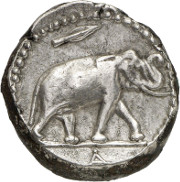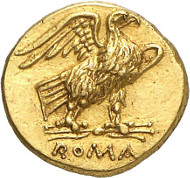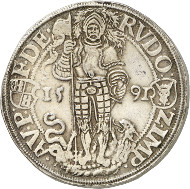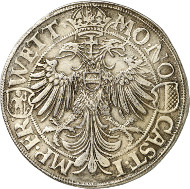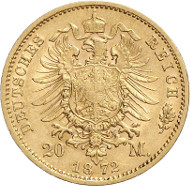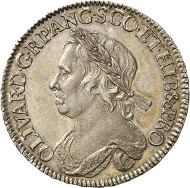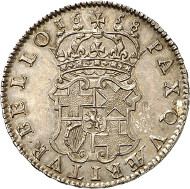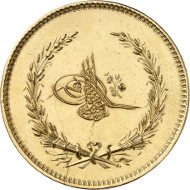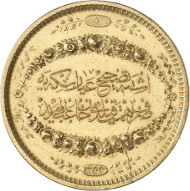04-10-2015 – 08-10-2015
Auction 232-234
Numismatic Rarities: From the Wappenmünze to the German Thaler
Over the course of its auction week, Gorny & Mosch will conduct three auction sales. The event on Monday will focus on high-quality ancient coins. On Tuesday and Wednesday, the “ordinary” ancient coins will come up for bid in Auction 233. In the auction to be held on Thursday, rarities from Medieval and Modern Times will be offered for sale. And the entire Friday will be devoted to Islamic coins as well as Russian coins, medals and decorations.
Auction 232 – High-Quality Ancient Coins
As always, the aficionado of the finest Greek coins will find a broad array of offers within the first catalog. Among others, the range includes a perfect early tetrachdrachm from Leontinoi, which was sold by Sambon-Canessa in 1927 (53 / EF / 7,500 euros), as well as an unsigned masterpiece of a Syracusan die cutter of the High Classical Period, depicting a monumental head of Arethusa (70 / VF / 26,000 euros). Anyone more fond of the rigid Archaic Period will surely find something to his or her liking, when turning to the coins from Northern Greece.
Lot 119: EDONES (Thraco-Macedonian Tribes). Octodrachm, ca. 479-465. Very rare. Extremely fine. Estimate: 80,000,- euros.
Maybe he will opt for the marvelous tetradrachm of King Getas of the Edones tribe with its meticulous depiction of a shepherd and his flock (119 / EF / 80,000 euros).
It goes without saying that the auction will also comprise numerous items for those who find great pleasure only in the great rarities. To name just a few: a tetradrachm from Apollonia Pontica (96 / EF / 12,000 euros), a bronze coin of the Thracian Dentheletes tribe (97 / VF / 4,500 euros), and an octodrachm of the Tyntenoi that is clearly modeled on the coinage of the Edones tribe (120 / VF / 15,000 euros).
What do you consider more important, a higher degree of rarity or a finer style? With the large series of coins from the city of Athens, there is no need to make a decision since the coins offered combine both: they are not only rare, but also stylistically charming. We would like to highlight the first so-called wappenmünze featuring the gorgon’s head on the obverse: This piece not only exhibits a superb Archaic style but is likewise exceptionally rare, notably in this perfect condition (178 / EF / 15,000 euros). The same applies to a wappenmünze with the depiction of a scarab (182 / EF / 15,000 euros). The Athenian tetradrachms virtually let the collector find the style he likes best, covering the entire range, from the finest Archaic (187 / EF / 5,000 euros) to Archaizing Classical (197 / EF / 1,500 euros) and Hellenistic (206 / EF / 750 euros).
Lot 293: SELEUCUS I (312-281). Tetradrachm, 288-287, Susa. Very rare. Nearly extremely fine. Estimate: 20,000,- euros.
With a small series from Crete and many rarities from Asia Minor, we are now turning to the Near East. This segment includes an extremely rare tetradrachm of Seleucus I with an Indian elephant on the reverse (293 / nearly EF / 20,000 euros) and a series of interesting Sassanid coins.
As always, Gorny & Mosch likewise offers some superb examples of Roman Provincial coinage, such as a cistophorus of Claudius showing on the reverse the Temple of Artemis at Ephesus (332 / nearly EF / 2,500 euros).
While the anonymous 60 asses gold coins of the 211 Roman monetary reform are rather frequent, their counterpart with a nominal value of 40 asses can only rarely be found.
Lot 351: ROMAN REPUBLIC. Anonymous. 40 asses, 211-207, Rome. Extremely rare. Extremely fine. Estimate: 25,000,- euros.
A perfect example of this type will be offered (351 / EF / 25,000 euros). This is just one of many pieces proving that the admirers of Roman numismatics – whether gold, silver or bronze, whether Republic, Imperial or Late Rome – will certainly find “their” favorite item. The fans of perfect bronze coins with the finest patina are particularly likely to discover many highlights. One example may suffice: a superb sestertius of Trajan with the still unidentified bridge on the reverse (430 / EF / 6,000 euros). Needless to add, that this segment includes great rarities as well, such as a sestertius of Britannicus (407 / VF / 4,500 euros).
Of course, the great number of aurei in highest grades deserves mentioning as well. To give only a few examples: Domitian as Caesar, rev. the imperial son riding a horse, raising his hand in an oratorical gesture (423 / EF / 20,000 euros), Commodus, rev. Castor leading a horse (449 / EF / 20,000 euros), and Philippus Arabs, rev. Liberalitas (467 / FDC / 32,000 euros).
Lot 524: VALENTINIANUS, 364-375. Multiple of 9 solidi, Rome. Unique. Unpublished. Very fine. Estimate: 75,000,- euros.
Last but not least, there are the two medallions which likewise add to the broad array of magnificent numismatic diversity: a bronze medallion of Septimius Severus, showing the emperor and his sons addressing the army (456 / EF / 35,000 euros), and a large gold medallion of 9 solidi, which was probably awarded by Valentinian I to a barbarian ruler (524 / VF / 75,000 euros).
Finally, Byzantine coins will conclude this sale. This segment comprises many rarities as well, such as solidi of the empresses Eudoxia and Irene. We would like to highlight a miliaresion of the short-reigning usurper Artavasdus, which is really hard to come by on the market (605 / VF-EF / 3,000 euros).
Auction 233 – Ancient Coins and Multiple Lots
Auction 233 offers more than 2,000 lots consisting of ancient coins – from the Celts and the Greeks to the Romans and Byzantium – as well as multiple lots and numismatic literature. Collectors of Greek fractions and bronze coins will make more than one amazing find.
Lot 1085: HERACLEA (Lucania). AE, 380-281. Very fine. Estimate: 120,- euros.
One such find may be a coin from the Lucanian city of Heraclea, featuring a river god with a fishtail on the reverse once sold in a Sternberg sale (1085 / VF / 120 euros).
The collector of Roman coins will likewise discover many pieces of high historical interest: for example, a portrait of Fulvia, Marc Antony’s first wife (2023 / nearly EF / 200 euros), or a denarius of Septimius Severus with a depiction of an animal fight (2418 / VF / 800 euros).
Of course, Gorny & Mosch will offer their multiple lots as well which are virtually famous and keep attracting collectors and dealers from all around the world. This time, the segment consists of more than 200 catalog numbers.
Auction 234 – Medieval and Modern Coins / German Thaler / Islam / Russia
This time, collectors of coins from pre-1871 Germany are very likely to rejoice about the range of offers which is a class of its own. Rarities will alternate with interesting series. The thaler-like coins come in particularly outstanding grades.
For starters, there is an extraordinary collection of perfect thaler of the Free Imperial City of Augsburg. From a fine city scape, an enthroned Augusta Vindelicorum or an emperor’ portrait, to the river deities of Lech and Wertach, all pieces on sale impress with their outstanding grades.
Lot 4115: FRIEDBERG. 1591 double thaler. Unique. Extremely fine. Estimate: 40,000,- euros.
These magnificent specimens vie with the almost omnipresent showpieces for the collector’s attention. Here are a few: a 1777 gold medal on Charles Theodore taking office in Bavaria (4028 / EF-FDC / 25,000 euros), a 1790 ducat of Count Charles August of Bretzenheim (4088 / FDC / 6,500 euros), a 1652 thaler of Corvey, of which only 214 specimens were struck (4094 / EF / 10,000 euros), a unique 1591 double thaler of the Free Imperial City of Friedberg (4115 / EF / 40,000 euros), a very rare double thaler of Lippe, minted in Detmold in 1685 (4151 / VF-EF / 20,000 euros), a 1673 broad double thaler of the city of Magdeburg, the second specimen known to exist (4153 / VF-EF / 30,000 euros), a 1638 5 ducat piece of Ferdinand I of Bavaria as bishop of Münster (4162 / EF / 30,000 euros), a 1830 prämienthaler of the Saxon King Anthony, of which only 25 specimens were produced (4224 / EF-FDC / 20,000 euros), as well as a 1677 thaler on the death of William Louis, Duke of Wuerttemberg (4267 / EF-FDC / 20,000 euros).
Lot 4415: SAXE-COBURG-GOTHA. Ernest II, 1844-1893. 1677 20 mark E. Extremely rare. Nearly extremely fine / extremely fine. Estimate: 65,000,- euros.
With all these pre-1871 German beauties in sight, one should not forget the equally remarkable rest. It consists of coins of the German Empire with many great rarities in the finest grades possible. The piece with the highest pre-sale estimate may serve as an example: the rarest of all imperial gold coin types, the 20 mark piece, struck in 1872 for Ernest II of Saxe-Coburg-Gotha (4415 / nearly EF / EF / 65,000 euros).
This takes us right to the department of medals where two collection fields stand out. The first consists of 58 lots of medals created by the popular Finnish medalist Kauko Räsänen, followed up by nearly 20 lots with aeronautical topics, including numerous depictions of balloons and the zeppelin.
The world coins section offers some big surprises as well, such as several Viking coins from Denmark and England which the specialized collector will surely appreciate. Among the coins of this section, an outstanding item can be found with a penny of Alfred the Great (4732A / VF / 5,000 euros).
Lot 4733: GREAT BRITAIN. Oliver Cromwell. 1658 halfcrown, London. Very rare. Extremely fine to FDC. Estimate: 5,000,- euros.
Anybody more interested in the later history of the United Kingdom might prefer the perfect halfcrown of Oliver Cromwell, showing an impressive portrait of this politician (4773 / EF-FDC / 5,000 euros).
From the advocate of puritanism to the defender of the Catholic faith, the collectors of Vatican coins and medals are recommended to carefully examine the catalog. Featuring coins from many mints, some of them very sought-after (e.g. Avignon), it lists 48 lots, ranging from the coinage of Paul II (1464-1471) to the current Pope Francis I. Some lots consist of only one item while others are composed of a couple of interesting pieces.
Also the multiple lots are worth a close look at the catalog and a long close look when being viewed. To refer to just one example: Lot 4984 consists of eight albums of more than 2,000 coins of post-1871 Germany. The lot is estimated at 1,000 euros which, however, strikes as a starting price with which the bidding will begin.
Lot 5153: OTTOMANS. Abd al-Majid, 1839-1861. On the monetary reform and the adoption of a new monetary system. Unique in this weight. Extremely fine to FDC. Estimate: 30,000,- euros.
Friday morning begins with Islamic coinages. Two small collections will be offered for sale: first, a range of non-Ottoman silver and copper coins, including some remarkable rarities. A collection of Ottoman gold coins featuring many rarities and outstanding quality items culminates in the presentation of the gold medal of Abd al-Majid (1839-1861) on the monetary reform and the adoption of a new monetary system, the medal coming up in a unique weight-entity.
The Russian coins are next. This segment will kick off with a small collection of about 50 lots of Russian dengi. The pieces on offer, some of them extremely rare, come from the successor states and the cities of the post-14th century Russian Empire and will please the collector with their broad range of motifs.
Needless to add, that the Russian section contains a lot of interesting rarities, especially when it comes to orders and decorations. Here are a few: a rare Order of St. Anne (6289 / good EF / 50,000 euros), a mounted medal of Alexander II on the 50th anniversary of the Russian Tsar as patron of the 3rd Prussian Uhlan Regiment (6300 / VF-EF / 50,000 euros), and a mounted bravery medal of Alexander III (6301 / nearly FDC / 50,000 euros).
All catalogs can be viewed on the internet here. Printed copies may be ordered at Gorny & Mosch, Giessener Münzhandlung, Maximiliansplatz 20, D-80333 Munich, phone +49 / (0)89 / 24 22 643-0, telefax +49 / (0)89 / 22 85 513.







